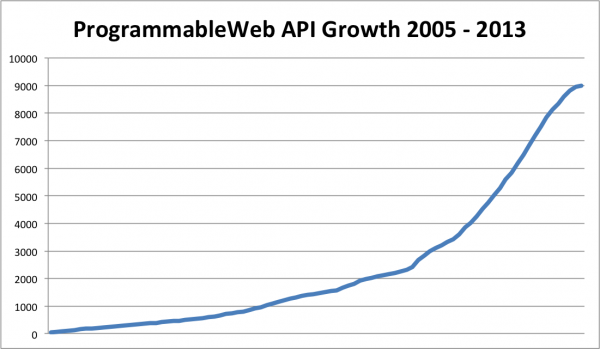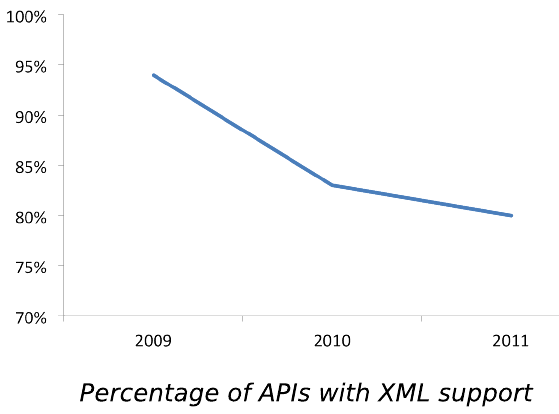How to create a Web API
no one wants to use
By Karoline Klever / @karolikl

Taking a look
at the world of Web APIs...
Your car has one
Chuck Norris has one
Your dog has one
The number of Web APIs
is increasing fast

1995
"Why do we need a website?"
2000
"Of course we have a website!"
2005
"Why do we need an API?"
2010
"Of course we have an API!"
URI Design
Badly named and inconsistent URIs that violate the Principle of Least Astonishment will make your web API just as disappointing as the movie "Sharknado".
Principle of Least Astonishment
"[...] a programmer should try to think of the behavior that will least surprise someone who uses the program, rather than that behavior that is natural from knowing the inner workings of the program."
Problem #1
Inconsistent URI structure
We cannot guess the URI of an endpoint based on our experience with the other endpoints.
Problem #2
URIs are not hackable
/all_links_for_city_of/chicago/il.json
/all_links_for_city_of/chicago/il.json
/all_links_for_city_of/chicago/il.json
Problem #3
Link types
/all_links_for_city_of/chicago/il.json
/all_links_for_county_of/cook%20county/il.json
/primary_links_for_city_of/chicago/il.json
/primary_links_for_county_of/cook%20county/il.json
Possible solution
(One of many)
/links
/links/il
/links/il/cook%20county
/links/il/cook%20county/chicago
/links/il/cook%20county/chicago?type=primary
HTTP Verbs
Why do we need anything other than GET?
The most commonly used
GET
PUT
POST
DELETE
Safe methods
"... the convention has been established that the GET and HEAD methods SHOULD NOT have the significance of taking an action other than retrieval. These methods ought to be considered "safe"."
Are they safe?
GET: Yes
PUT: No
POST: No
DELETE: No
Idempotent methods
Methods we can issue the same request against as many times as we want without changing the result.
Are they idempotent?
GET: Yes
PUT: Yes
POST: No
DELETE: Yes
Get climate
GET /vehicles/{id}/command/climate_state
{
"inside_temp": 17.0,
"outside_temp": 9.5,
"driver_temp_setting": 22.6,
"passenger_temp_setting": 22.6,
"is_auto_conditioning_on": false,
"is_front_defroster_on": null,
"is_rear_defroster_on": false,
"fan_status": 0
}
Open sunroof
GET /vehicles/{id}/command/sun_roof_control?state=openPossible solution
GET /vehicles/{id}/command/sun_roof_control
{
"state": "open"
}
PUT /vehicles/{id}/command/sun_roof_control?state=open
{
"result": true
}
The other Verbs?
| GET | Returns the state of the sun roof (open/closed) |
|---|---|
| PUT | Open/close the sunroof |
| POST | Not supported, cannot create new sun roof |
| DELETE | Not supported, cannot delete sun roof |
A must read
Section 9 «Method definitions» in RFC 2616
https://tools.ietf.org/html/rfc2616#section-9HTTP Status Codes
Everyone just loves an "error in disguise".
Problem #1
Disguising your errors
Invalid requests return with a 200 OK status code, giving the impression that the request was successful.
Problem #2
Displaying your internals
Including a detailed error report or stack trace makes your Web API vulnerable to attack
The basics
| 2xx | Awesome! |
|---|---|
| 4xx | The user of the API made a mistake |
| 5xx | The creator of the API made a mistake |
Possible solution
GET http://api.worldbank.org/countries/a?format=json 404 Not FoundGET http://api.worldbank.org/topic?format:json 400 Bad RequestA must read
Section 10 «Status Code Definitions» in RFC 2616
https://tools.ietf.org/html/rfc2616#section-10Result Formatting
Dictating the format will drive developers away.
XML is on decline
Hurray!

Possible solutions
- URL extensions
- Query string parameters
- Content negotiation
Versioning
However perfect you make your web API, you're bound to find a way that's even more perfect before long, and then you'll need to launch a new version.
Capture5 -> Complete / Cancel2
URL versioning
GET https://api.twitter.com/1.1/trends/place.json?id=1 Query string parameters
GET http://api-public.netflix.com/catalog/titles/series/7002352?v=1.5 GET https://api.foursquare.com/v2/venues/40a55d80f964a52020f31ee3?oauth_token=XXX&v=YYYYMMDD Vendor Specific Accept Header
HEADER Accept: {type}/vnd.{company}.{version}+{type}HEADER Accept: {type}/vnd.{company}+{type}; version={version}HEADER Accept: application/vnd.github.v3+jsonHEADER Accept: application/vnd.github+json; version=3Custom Request Header
HEADER x-ms-version: 2014-02-14HEADER api-version: 2Summary
URI design
HTTP Verbs
HTTP Status Codes
Result Formatting
Versioning
Questions?
Thank you!
By Karoline Klever / @karolikl / karolikl@gmail.com
